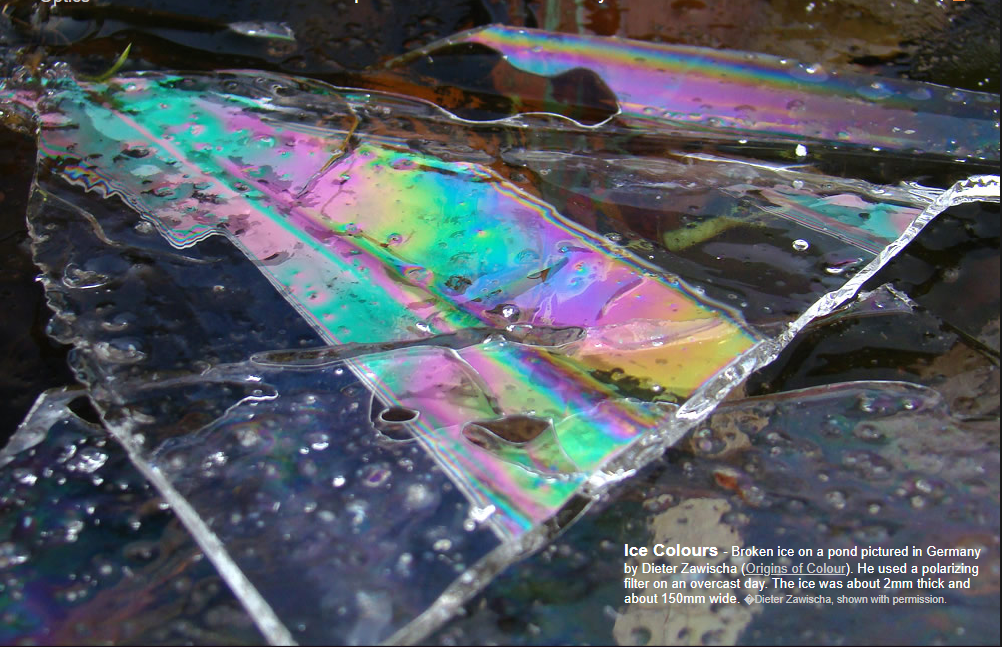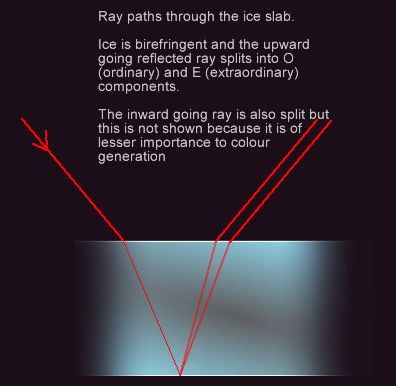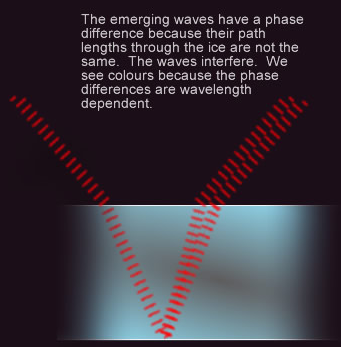Ice Colours
Exploring the Enigmatic Ice Colours
Have you ever come across the mesmerizing sight of broken ice on a pond, adorned with an array of vibrant colors? This intriguing phenomenon, known as "Ice Colours," is caused by a fascinating optical effect called birefringence or double refraction. While the existing content provides a brief overview, let's dive deeper into the science behind this captivating natural spectacle.
Unveiling the Stages of Ice Colour Formation
Ice Colours originate from the interplay of light and ice. Here's a breakdown of the stages involved:
-
Polarization of Sky Light: Initially, the light from an overcast sky enters the scene without any polarization or with minimal polarization.
-
Light Entering the Ice: Rays of light penetrate the ice, commencing their journey through its crystalline structure.
-
Reflection from Ice-Air Interface: When an air layer exists beneath the ice slab, some rays reflect back upwards from the lower ice-air interface surface. These reflected rays become linearly polarized. The extent of polarization depends on the viewing angle and is at its maximum at the "Brewster angle."
-
Birefringence at Play: At this stage, the birefringence of ice becomes significant. It splits the upcoming rays into two components - an Ordinary (O) ray and an Extraordinary (E) ray. The Extraordinary ray earned its name due to its refraction behavior, which deviates from Snell's law.
-
Interference and Colour Production: The O and E rays pass through the polarizing filter on the camera and interfere with each other, giving rise to the enchanting display of colors we observe in Ice Colours.
Unraveling the Color Transformation
One intriguing aspect of Ice Colours is their ability to change when the camera's polarizing filter is rotated. This transformation serves as a key indicator of birefringence's role in this phenomenon. In contrast, colors generated by thin film interference in cracks and gaps between ice sheets would not change in hue but only in intensity when the filter is rotated.
Beyond Ice Colours: Ice's Influence on Atmospheric Optics
While Ice Colours are a captivating sight on their own, the birefringence of ice also has subtle influences on other atmospheric optical phenomena:
-
Halos: The birefringence of ice slightly influences the appearance of halos, those mesmerizing circles of light that encircle the sun or moon.
-
Sundogs: Sundogs, also known as parhelia, are bright spots that appear on either side of the sun, often accompanied by a halo. These sundogs consist of two differently polarized components. By using a polarizing filter quickly before the sundog changes shape, one can separate these components and capture their distinct characteristics.
Embracing the Wonder: Polarizing Filters
To fully appreciate the beauty and intricacy of atmospheric optics, it is highly recommended to keep a polarizing filter handy, even if you don't plan on using it with a camera. A piece of Polaroid or an old sunglass lens can serve this purpose effectively. By utilizing a polarizing filter, you can explore and capture remarkable reflections from ice, water, rainbows, fogbows, and even a glory when soaring through the sky.
In conclusion, Ice Colours are a captivating manifestation of birefringence in ice. Understanding the stages involved and the impact of birefringence on atmospheric optics enables us to appreciate the intricate dance between light and ice. So, next time you encounter broken ice on a pond, take a moment to marvel at the magical world of Ice Colours and the wonders that atmospheric optics has to offer.

Ice Colours - Broken ice on a pond pictured in Germany by Dieter Zawischa (Origins of Colour). He used a polarizing filter on an overcast day. The ice was about 2mm thick and about 150mm wide. �Dieter Zawischa, shown with permission.
Birefringence (double refraction) is the cause of these colours. The effects are similar to those seen in airplane windows and in transparent plastic objects reflecting the polarised light of computer monitors.
There are several stages:
(1) The light from an overcast sky is not polarised or only very weakly so.
(2) Rays enter the ice.
(3) When there is an air layer beneath the the ice slab, some rays are reflected back upwards from the lower ice-air interface surface. These rays are linearly polarised. The extent of polarisation depends on the viewing angle and is maximum at the �Brewster angle�. Here, Dieter chose a position where the polarization was strong.
(4) At this stage the ice birefringence becomes important. It splits the upcoming rays into two components � an O (ordinary) ray and E (extraordinary) ray. The extraordinary ray was so named because its refraction is not predictable by Snell�s law.
(5) The rays pass through the polarising filter on the camera and interfere to produce the colours.
The colours change when the camera polarising filter is rotated. This is a key to identifying whether birefringence is responsible. Colours might also be generated by thin film interference in cracks and gaps between ice sheets but these would not change in hue (they do in intensity) when a filter is rotated.
The birefringence of ice influences halos slightly and a sundog has two differently polarised components. These can be separated if you work quickly with a polarizing filter before the dog changes shape. Richard Fleet has a good set of images.
It is good practice to keep a polarising filter with you even if it is not used on a camera. A piece of Polaroid or a lens from some old sunglasses will do. Try it on reflections from ice, water, rainbows and fogbows, and if you are airborne a glory.
Thanks to Dieter Zawischa for very helpful discussions. Visit his site describing origins of colour in Nature..

Ray paths through the ice slab. Ice is birefringent and the upward
going reflected ray splits into O (ordinary) and E (extraordinary)
components.
The inward going ray is also split but this is not shown because it is of
lesser importance to colour generation

The emerging waves have a phase difference because their path lengths through the ice are not the same. The waves interfere. We see colours because the phase differences are wavelength dependent.
Note: this article has been automatically converted from the old site and may not appear as intended. You can find the original article here.
Reference Atmospheric Optics
If you use any of the definitions, information, or data presented on Atmospheric Optics, please copy the link or reference below to properly credit us as the reference source. Thank you!
-
<a href="https://atoptics.co.uk/blog/ice-colours/">Ice Colours</a>
-
"Ice Colours". Atmospheric Optics. Accessed on April 16, 2024. https://atoptics.co.uk/blog/ice-colours/.
-
"Ice Colours". Atmospheric Optics, https://atoptics.co.uk/blog/ice-colours/. Accessed 16 April, 2024
-
Ice Colours. Atmospheric Optics. Retrieved from https://atoptics.co.uk/blog/ice-colours/.